Spatial and Temporal Evolution of Ecosystem Service Values and Topography-Driven Effects Based on Land Use Change: A Case Study of the Guangdong–Hong Kong–Macao Greater Bay Area
Abstract
1. Introduction
2. Materials and Methods
2.1. Study Area Overview
2.2. Data Sources and Initial Data Processing
2.3. Research Methods
2.3.1. Analysis of Land Use Change
2.3.2. Ecosystem Service Value at the Grid Scale
2.3.3. Markov Model
2.3.4. Geographically Weighted Regression Model
3. Results
3.1. Analysis of Spatial and Temporal Land Use Change Characteristics
3.1.1. Land Use Transfer Matrix
3.1.2. Shift in Land Use Focus
3.2. Analysis of the Spatial and Temporal Evolution of Ecosystem Service Values
3.2.1. Time Series Changes in Ecosystem Service Values
3.2.2. Spatial Changes in Ecosystem Service Values
3.2.3. Forecasting the Ecosystem Service Values
3.3. Analysis of the Topographic Factor-Driven Effects of Ecosystem Service Value
4. Discussion and Conclusions
4.1. Discussion
4.1.1. Land Use Change Significantly Affects Ecosystem Service Values
4.1.2. Spatial and Temporal Variation in Ecosystem Service Values and Strategies for Optimization
4.1.3. Topographic Factors and Ecosystem Service Values
4.1.4. Sustainability in the Guangdong–Hong Kong–Macao Greater Bay Area
4.2. Conclusions
- (1)
- Over the past 20 years, in terms of the shift in the land area, the most obvious fluctuations are in the areas of water, arable land and construction land; the northwestern and northeastern areas with high vegetation cover gradually decreased, while the impervious area of the urban agglomerations in the central area is increasing, and the ecological land around the urban agglomerations, such as arable land and wetlands, is decreasing. In terms of the shift in the center of gravity of the land, the center of gravity of all types of land has shifted to different degrees, with the center of gravity of construction land shifting northward, while the center of gravity of grassland and unused land shifted westward, and the center of gravity of forest land has shifted northwestward, with significant contradictions between the survival of ecological land and the expansion of urban construction land.
- (2)
- From an overall perspective, the ESVs in the GBA from highest to lowest are the following: regulating services > supporting services > provisioning services > cultural services. Hydrological regulation, biodiversity and soil conservation are the three items that contribute the most to the values of individual ESs. In terms of temporal changes, the ESs in the GBA showed a decreasing trend in the overall and individual values over the 20-year period. In terms of the spatial changes in rank, the area with the lowest ESV rank is located in the dense urban area in the central part of the GBA, accounting for 35% of the total area and increasing in size, indicating the deteriorating quality of the habitat; the area with a relatively high ESV rank is located in the city of Zhaoqing, northeastern Huizhou and Jiangmen in the GBA, accounting for 27% of the total area. The Markov model predicts that the ecosystem service value in 2030 shows a decreasing trend under the development of a natural state.
- (3)
- The spatial distribution of ESVs in the GBA is aggregated, and there is a regional adjacency between the high-value and low-value areas of ESVs. From 2010 to 2020, the “high” area continues to develop to the south, and the scope of the low-value aggregation area is also expanding. The construction land in the low-value area is increasing, and the population and traffic pressure are becoming bigger and bigger, which has a great impact on the urban green space system and reduces the anti-disturbance ability of the inner-city green space ecosystem.
- (4)
- There is a significant correlation between topographic factors and ESV, where topographic factors have a strong influence on ESVs mainly in the northwestern and northeastern parts of the GBA, and the coupling analysis with the land use data show that the main land types in this area are forest land, arable land and water. At the same time, the influence of the water–land intersection zone in the south is also obvious; the weaker influence is mainly located in the central part of the study area and the border area, and the main land types are construction land, dike-ponds and forest land.
Author Contributions
Funding
Data Availability Statement
Conflicts of Interest
References
- Liu, Y.; Yan, Y.; Li, X. An Empirical Analysis of an Integrated Accounting Method to Assess the Non-Monetary and Monetary Value of Ecosystem Services. Sustainability 2020, 12, 8296. [Google Scholar] [CrossRef]
- Li, X.; Zhou, J.; Huang, Y.; Huang, M. Understanding the Guangdong-Hong Kong-Macao Greater Bay Area from the perspective of megacity region. Prog. Geogr. 2018, 37, 1609–1622. [Google Scholar]
- Feng, S.; Fan, F. Spatiotemporal changes of landscape pattern using impervious surface in Guangdong-Hong Kong-Macao Greater Bay Area, China Hong Kong-Macao Greater Bay Area, China. J. Appl. Ecol. 2018, 29, 2907–2914. [Google Scholar]
- SCEP. Man’s Impact on the Global Environment: Study of Critical Environmental Problems; MIT Press: Cambridge, MA, USA, 1970. [Google Scholar]
- Liu, X. Ecosystem Services. Environ. Her. 1998, 1, 44. [Google Scholar]
- Ouyang, Z.; Zheng, H. Ecological mechanisms of ecosystem services. Acta Ecol. Sin. 2009, 29, 6183–6188. [Google Scholar]
- Xie, G.; Xiao, Y.; Zhen, L.; Lu, C. Study on ecosystem services value of food production in China. Chin. J. Eco-Agric. 2005, 13, 10–13. [Google Scholar]
- Yan, S.; Wang, X. Advances of Research on Ecosystem Service. Chin. J. Ecol. 2002, 21, 61–68. [Google Scholar]
- Aodeng, G.; Liang, Y.; Han, G. Overview of grassland ecosystem service functions and their eco-economic value. Inn. Mong. Prataculture 2004, 16, 46–47. [Google Scholar]
- Li, L.; Wang, X.; Luo, L.; Yi, X.; Zhao, Y.; Zhao, Y.; Bachagha, N. A systematic review on the methods of ecosystem services value assessment. Chin. J. Ecol. 2018, 37, 1233–1245. [Google Scholar] [CrossRef]
- Kareiva, P.; Marvier, M. Conserving biodiversity coldspots-Recent calls to direct conservation funding to the world’s biodiversity hotspots may be bad investment advice. Am. Sci. 2003, 4, 220–224. [Google Scholar]
- Robertson, G.P.; Swinton, S.M. Reconciling agricultural productivity and environmental integrity: A grand challenge for agriculture. Front. Ecol. Environ. 2005, 1, 38–46. [Google Scholar] [CrossRef]
- Li, L.; Lin, W.; Ren, C.; Xv, D. Comparative Study on Two Assessment Methods of Ecosystem Service Value—A Case Study of Hangzhou Bay Area. Res. Soil Water Conserv. 2022, 29, 228–234. [Google Scholar]
- Zhou, Y.; Yi, L.; Kuang, H.; He, Y.; Yang, D.; Zhou, L. Study on the Changes and Ecological System Service Values in Guangdong-Hong Kong-Macao Greater Bay Area. Environ. Prot. 2019, 47, 56–60. [Google Scholar]
- Wang, S.; Huang, L.; Xv, X.; Xv, S. Spatial and temporal evolution of ecosystem services and its trade-offs and synergies in Guangdong-Hong KongMacao Greater Bay Area. Acta Ecol. Sin. 2020, 40, 8403–8416. [Google Scholar]
- Lin, M.; Zhou, R.; Zhong, L. Research on the changes of ecosystem services in Guangdong-Hong Kong-Macao Greater Bay Area based on the change of landscape pattern. J. Guangzhou Univ. (Nat. Sci. Ed.) 2019, 18, 87–95. [Google Scholar]
- Li, J.; Wang, J. Identification, classification, and mapping of coastal ecosystem services of the Guangdong, Hong Kong, and Macao Great Bay Area. Acta Ecol. Sin. 2019, 39, 6393–6403. [Google Scholar]
- Costanza, R.; d’Arge, R.; De Groot, R.; Farber, S.; Grasso, M.; Hannon, B.; Limburg, K.; Naeem, S.; O’neill, R.V.; Paruelo, J.; et al. The value of the world’s ecosystem services and natural capital. Nature 1997, 387, 253–260. [Google Scholar] [CrossRef]
- Xie, G.; Zhang, C.; Zhang, L.; Chen, W.; Li, S. Improvement of the Evaluation Method for Ecosystem Service Value Based on Per Unit Area. J. Nat. Resour. 2015, 30, 1243–1254. [Google Scholar]
- Wang, W.; Guo, H.; Chuai, X.; Dai, C.; Lai, L.; Zhang, M. The impact of land use change on the temporospatial variations of ecosystems servicesvalue in China and an optimized land use solution. Environ. Sci. Policy 2014, 44, 62–72. [Google Scholar] [CrossRef]
- Xie, W.; Fu, W.; Yang, D.; Liu, J. Spatio-temporal Evolution and Simulation Forecast of Ecosystem Service Value in Jiangsu Province Based on Land Use Changes. Areal Res. Dev. 2022, 41, 126–158. [Google Scholar]
- Ma, S.; Shi, M.; Yang, G.; Xv, X.; Yin, J. Analysis on spatiotemporal Change of Land Use Based on GIS Technology—Taking Xingjiang Tarim Basin as an Example. Res. Soil Water Conserv. 2013, 20, 177–181. [Google Scholar]
- Hu, X.; Hong, W.; Wu, C.; Qi, X. Spatiotemporal differentiation ofland eco-system service in Fuzhou City. China Environ. Sci. 2013, 33, 881–888. [Google Scholar]
- Wang, X.; Yan, F.; Su, F. Impacts of Urbanization on the Ecosystem Services in the Guangdong-Hong Kong-Macao Greater Bay Area, China. Remote Sens. 2020, 12, 3269. [Google Scholar] [CrossRef]
- Wu, L.; Sun, C.; Fan, F. Estimating the Characteristic Spatiotemporal Variation in Habitat Quality Using the InVEST Model—A Case Study from Guangdong-Hong Kong-Macao Greater Bay Area. Remote Sens. 2021, 13, 1008. [Google Scholar] [CrossRef]
- Liu, Y.; Hou, X.; Li, X.; Song, B.; Wang, C. Assessing and predicting changes in ecosystem service values based on land use/cover change in the Bohai Rim coastal zone. Ecol. Indic. 2020, 111, 106004. [Google Scholar] [CrossRef]
- Jiang, T. Thesis for Master Degree of Science Change of Farmland Ecosystem Services Values and Its Driving Forces in Northwestern Arid Area—A Case Study on Minqin County Tongchang JIANG. Master’s Thesis, Lanzhou University, Lanzhou, China, 2010. [Google Scholar]
- Yao, C.; Zhu, H.; Lv, X.; Liu, Y. Study on theImpact of Socio-economic Driving Factors of Land Use Change on the Ecosystem Service Values in Fujian Province. J. Nat. Resour. 2009, 24, 225–233. [Google Scholar]
- Chen, Y.; Li, J.; Xv, J. The influence of socio-economic factors on the value of ecological services in Hubei Province based on GWR. China Land Sci. 2015, 29, 89–96. [Google Scholar]
- Li, Q.; Li, T.; Yang, M.; Ying, W. Spatiotemporal variation of ecosystem services value based on gradient analysis in Wuhan. Acta Ecol. Sin. 2017, 37, 2118–2125. [Google Scholar]
- Yao, X.; Zhou, D.; Huang, W.; Liu, X. Spatial and temporal effects of ecosystem service values on topographic gradients in northwest Qianxi. Agric. Technol. 2022, 42, 93–100. [Google Scholar]
- Zhang, T.; Qu, Y.; Liu, Y.; Yan, G.; Foliente, G. Spatiotemporal Response of Ecosystem Service Values to Land Use Change in Xiamen, China. Sustainability 2022, 14, 12532. [Google Scholar] [CrossRef]
- Liu, Z.; Wang, S.; Fang, C. Spatiotemporal evolution and influencing mechanism of ecosystem service value in the Guangdong-Hong Kong-Macao Greater Bay Area. Acta Geogr. Sin. 2021, 76, 2797–2813. [Google Scholar]
- Wu, J.; Jiang, W.; Huang, Y. Spatial-Temporal Changes of Ecosystem Service Value in the Guangdong-Hong Kong-Macao Greater Bay Area. South Archit. 2022, 6, 52–61. [Google Scholar]
- Hou, J.; Qin, T.; Liu, S.; Wang, J.; Dong, B.; Yan, S.; Nie, H. Analysis and Prediction of Ecosystem Service Values Based on Land Use/Cover Change in the Yiluo River Basin. Sustainability 2021, 13, 6432. [Google Scholar] [CrossRef]
- Chunshan, Z.; Luo, L.; Shi, C.; Wang, J. Spatio-temporal Evolutionary Characteristics of the Economic Development in the Guangdong-Hong Kong-Macao Greater Bay Area and Its Influencing Factors. Trop. Geogr. 2017, 37, 802–813. [Google Scholar]
- Gu, S.; Cao, D.; Yang, M. The Strategic Thinking of Building Innovation Ecosystem in Guangdong-Hong Kong-Macao Greater Bay Area. Chin. Soft Sci. 2018, 4, 1–9. [Google Scholar]
- Zhu, M.; Fu, X. Spatial-temporal Evolution of Urban Land Use Efficiency in the Guangdong-Hong Kong-Macao Greater Bay Area. Trop. Geogr. 2017, 37, 814–823. [Google Scholar]
- Wang, F.; Gao, J.; Shao, H.; Zhang, T.; Zhang, Y.; Xv, X.; Zhao, C.; Wang, H. Response of ecosystem service values to land use change based on GIS and ecological compensation in Loess Plateau. Sci. Soil Water Conserv. 2013, 11, 25–31. [Google Scholar]
- Niu, X. Research on Distributed Assessment and Quantitative Compensation of Forest Ecological Benefit—Case Studies with Guangdong and Liaoning Provinces. Master’s Thesis, Beijing Forestry University, Beijing, China, 2012. [Google Scholar]
- Zhang, J.; Li, Q.; Wu, X.; Zhang, C.; Wang, J.; Wu, G. Evolution of the ecosystem services value and carrying capacity in the Guangdong-Hong KongMacao Greater Bay Area based on land use changes. Acta Ecol. Sin. 2021, 41, 8375–8386. [Google Scholar]
- Chang, X.; Li, X.; Diao, H. Analysis of spatial and temporal changes in land use and shift of focus in mining areas. J. Inn. Mong. Agric. Univ. (Nat. Sci. Ed.) 2021, 42, 41–48. [Google Scholar]
- Yang, G.; Lv, K.; Li, F. Spatial and Temporal Correlation Analysis of Land Use Change and Ecosystem Service Value in Nanchang City Based on Grid Scale. China Land Sci. 2022, 36, 121–130. [Google Scholar]
- Shi, Y.; Wang, R.; Huang, J.; Yang, W. Analysis of spatial and temporal variation in terrestrial ecosystem service functions in China. Sci. Bull. 2012, 57, 720–731. [Google Scholar] [CrossRef]
- Zhang, L.; Yu, X.; Jiang, M.; Xue, Z.; Lu, X.; Zou, Y. A consistent ecosystem services valuation method based on Total Economic Value and Equivalent Value Factors: A case study in the Sanjiang Plain, Northeast China. Ecol. Complex. 2017, 29, 40–48. [Google Scholar] [CrossRef]
- Xie, G.; Lu, C.; Cheng, S. Advances in global ecosystem service valuation research. Resour. Sci. 2001, 6, 5–9. [Google Scholar]
- Xv, Y.; Zhou, Y.; He, Y.; Kuang, H.; Yang, D. Study on the prediction of ecological system service values based on the changes of land use in Guangdong-Hongkong-Macau Greater Bay Area. Ecol. Sci. 2020, 39, 207–212. [Google Scholar]
- Luo, D.; Zhang, W. A comparison of Markov model-based methods for predicting the ecosystem service value of land use in Wuhan, central China. Ecosyst. Serv. 2014, 7, 57–65. [Google Scholar] [CrossRef]
- Gao, X.; Wang, J.; Li, C.; Shen, W.; Song, Z.; Nie, C.; Zhang, X. Land use change simulation and spatial analysis of ecosystem service value in Shijiazhuang under multi-scenarios. Environ. Sci. Pollut. Res. 2021, 28, 31043–31058. [Google Scholar] [CrossRef] [PubMed]
- Brunsdon, C.; Fotheringham, A.S.; Charlton, M.E. Geographically weighted regression: A method for exploring spatial nonstationarity. Geogr. Anal. 1996, 28, 281–298. [Google Scholar] [CrossRef]
- Noresah, M.S.; Ruslan, R. Modelling urban spatil structure using Geographically weighed Ression. In Proceedings of the 18th World IMACS Congress and MODMS09 International Congress on Modelling and Simulation, Cairns, Australia, 13–17 July 2009; Australian National University: Canberra, Australia, 2009; Volume 9, pp. 13–17. [Google Scholar]
- Platt, R.V. Global and local analysis of fragmentation in a mountain region of Colorado. Agric. Ecosyt. Environ. 2004, 2, 207–218. [Google Scholar] [CrossRef]
- Chen, X. Comparison and analysis of spatial prediction and variability of soil pH in Anhui Province based on three kinds of geographically weighted regression. Sci. Geogr. Sin. 2023, 5, 5–6. [Google Scholar]
- Hasan, S.S.; Zhen, L.; Miah, M.G.; Ahamed, T.; Samie, A. Impact of land use change on ecosystem services: A review. Environ. Dev. 2020, 34, 100527. [Google Scholar] [CrossRef]
- Fu, B.; Zhang, L. Land-use change and ecosystem services: Concepts, methods and progress. Prog. Geogr. 2014, 33, 441–446. [Google Scholar]
- Talukdar, S.; Singha, P.; Shahfahad; Mahato, S.; Praveen, B.; Rahman, A. Dynamics of ecosystem services (ESs) in response to land use land cover (LU/LC) changes in the lower Gangetic plain of India. Ecol. Indic. 2020, 112, 106121. [Google Scholar] [CrossRef]
- Wang, Y.; Shen, J.; Xiang, W. Ecosystem service of green infrastructure for adaptation to urban growth: Function and configuration. Ecosyst. Health Sustain. 2018, 4, 132–143. [Google Scholar] [CrossRef]
- Zheng, W.; Ke, X.; Xiao, B.; Zhou, T. Optimising land use allocation to balance ecosystem services and economic benefits-A case study in Wuhan, China. J. Environ. Manag. 2019, 248, 109306. [Google Scholar] [CrossRef]
- Jin, G.; Deng, X.; Chu, X.; Li, Z.; Wang, Y. Optimization of land-use management for ecosystem service improvement: A review. Phys. Chem. Earth Parts A/B/C 2017, 101, 70–77. [Google Scholar] [CrossRef]
- Jin, G.; Wang, P.; Zhao, T.; Bai, Y.; Zhao, C.; Chen, D. Reviews on land use change induced effects on regional hydrological ecosystem services for integrated water resources management. Phys. Chem. Earth Parts A/B/C 2015, 89–90, 33–39. [Google Scholar] [CrossRef]
- Liu, J.; Li, J.; Gao, Z.; Yang, M.; Qin, K.; Yang, X. Ecosystem Services Insights into Water Resources Management in China: A Case of Xi’an City. Int. J. Environ. Res. Public Health 2016, 13, 1169. [Google Scholar] [CrossRef] [PubMed]
- Picchi, P.; van Lierop, M.; Geneletti, D.; Stremke, S. Advancing the relationship between renewable energy and ecosystem services for landscape planning and design: A literature review. Ecosyst. Serv. 2019, 35, 241–259. [Google Scholar] [CrossRef]
- Xie, B.; Meng, S.; Zhang, M. Evolution of Habitat Quality and Its Response to Topographic Gradient Effect in a Karst Plateau: A Case Study of the Key Biodiversity Conservation Project Area of Wuling Mountains. Int. J. Environ. Res. Public Health 2023, 20, 331. [Google Scholar] [CrossRef]
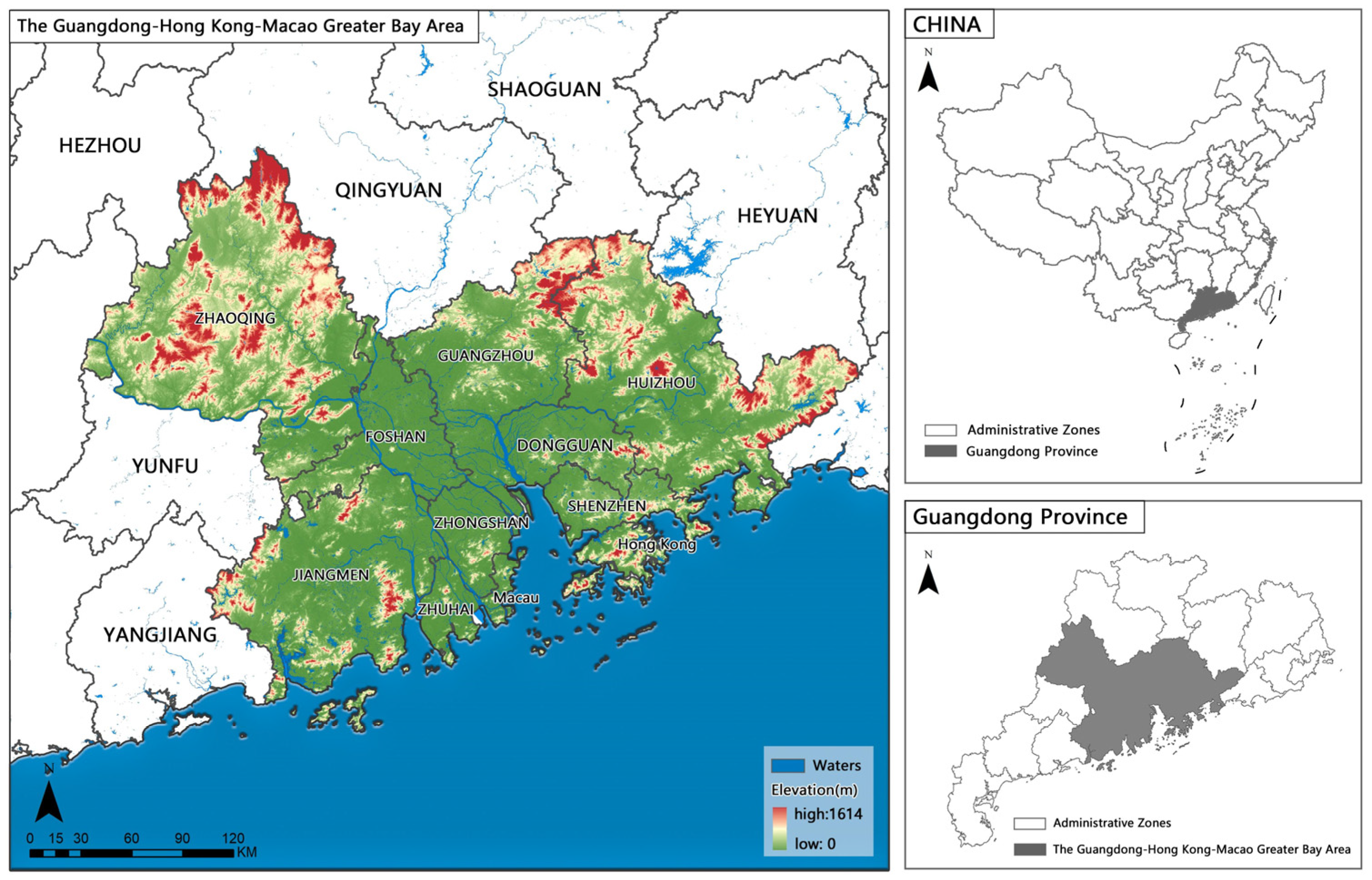
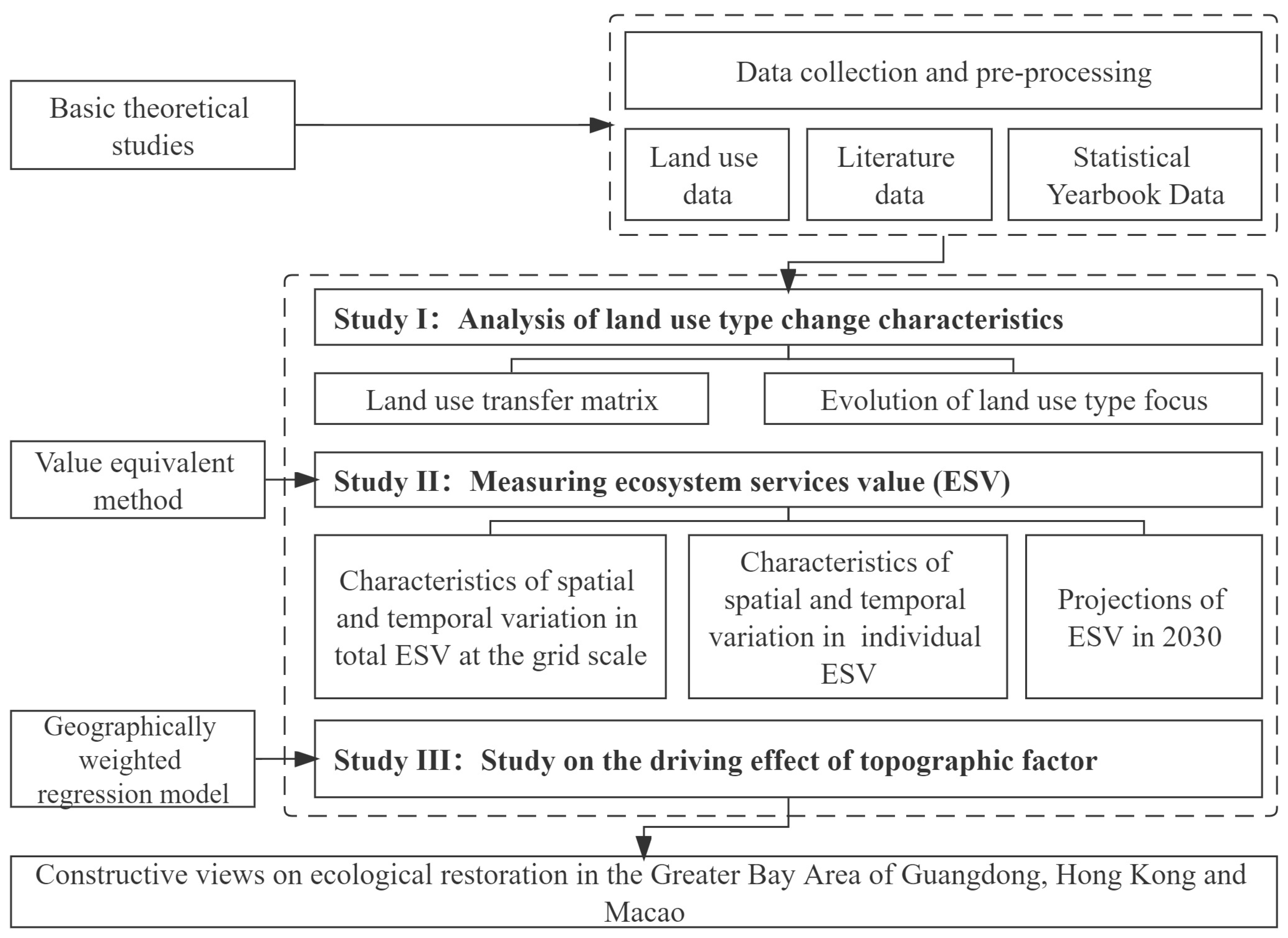
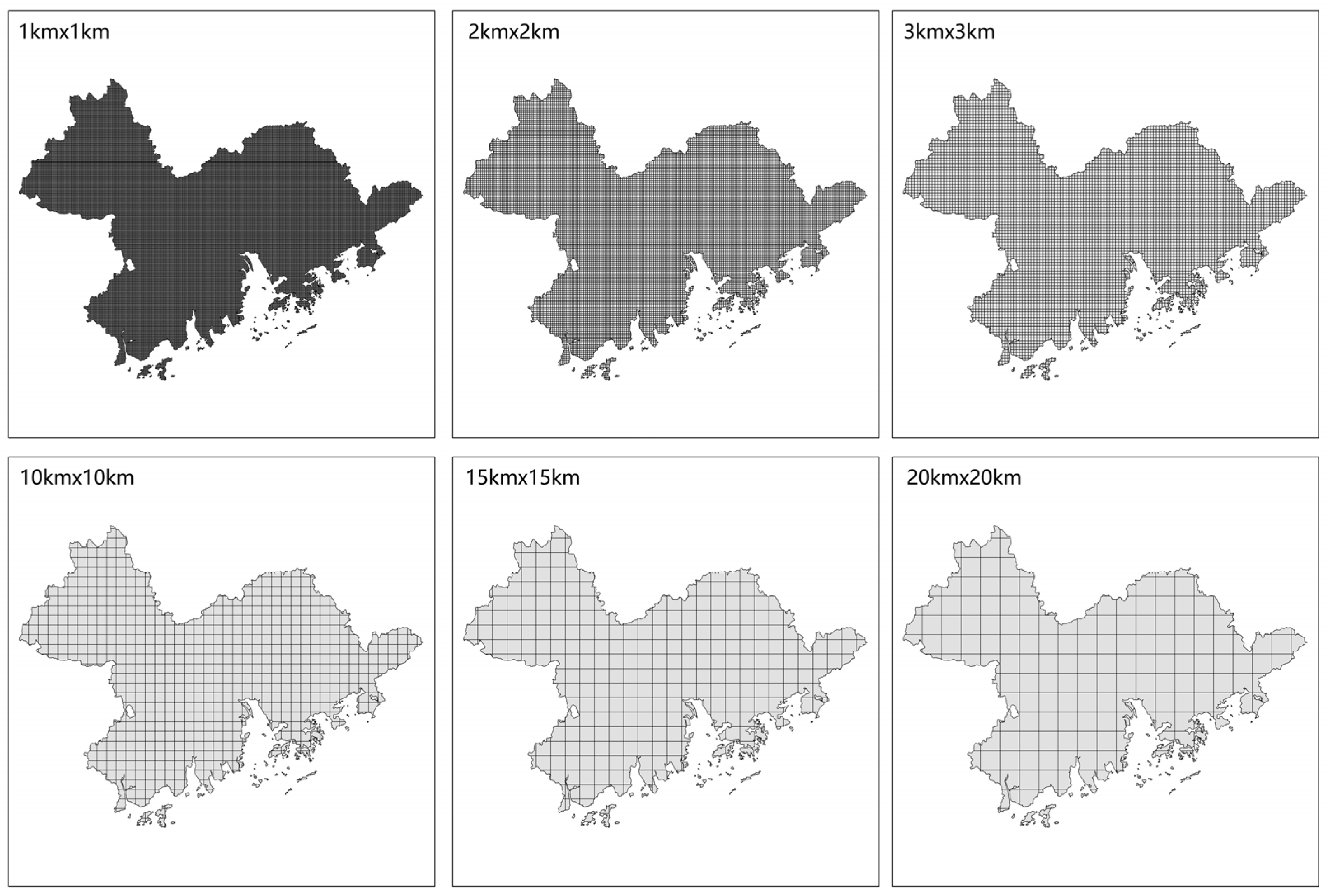

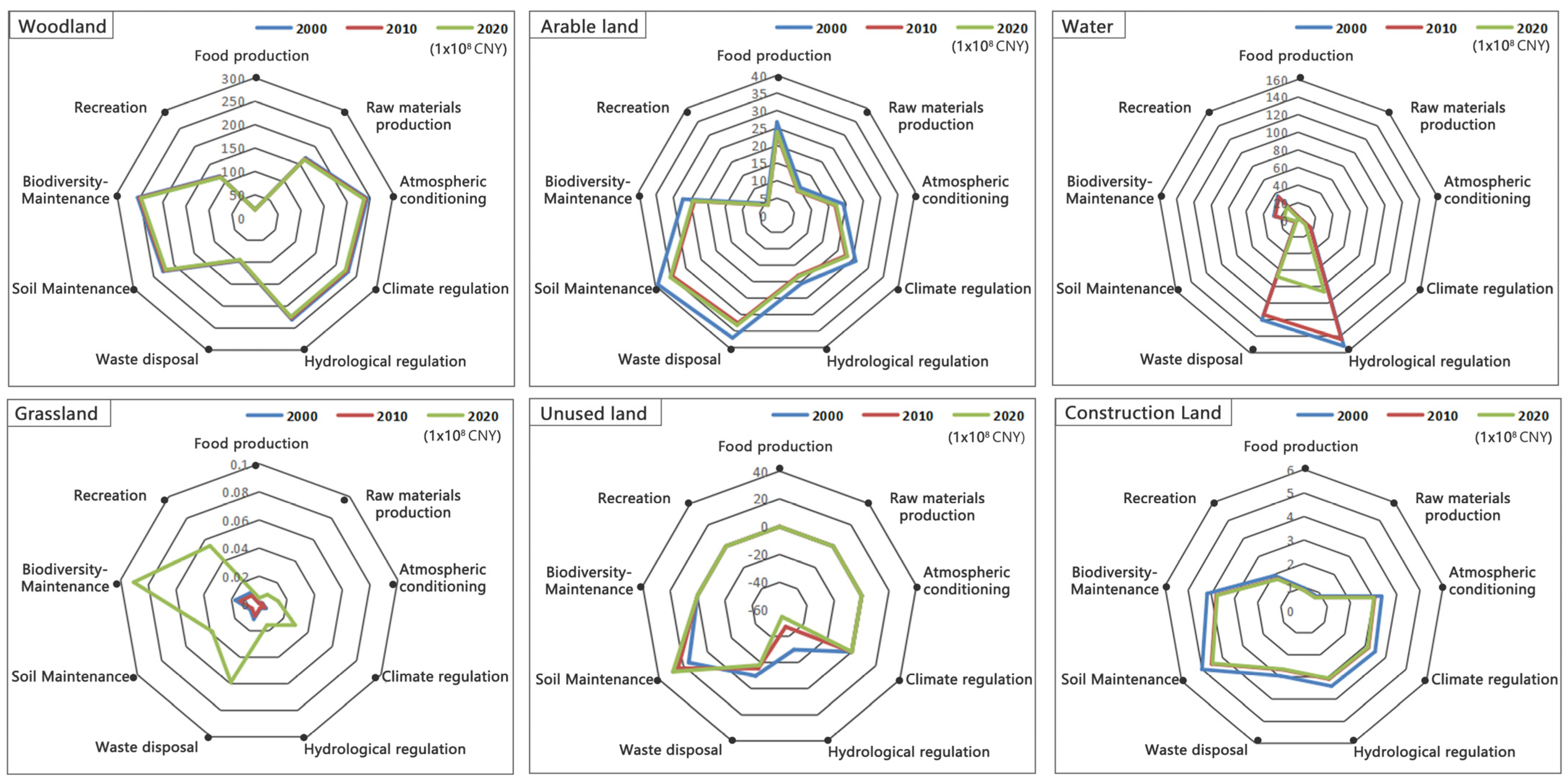
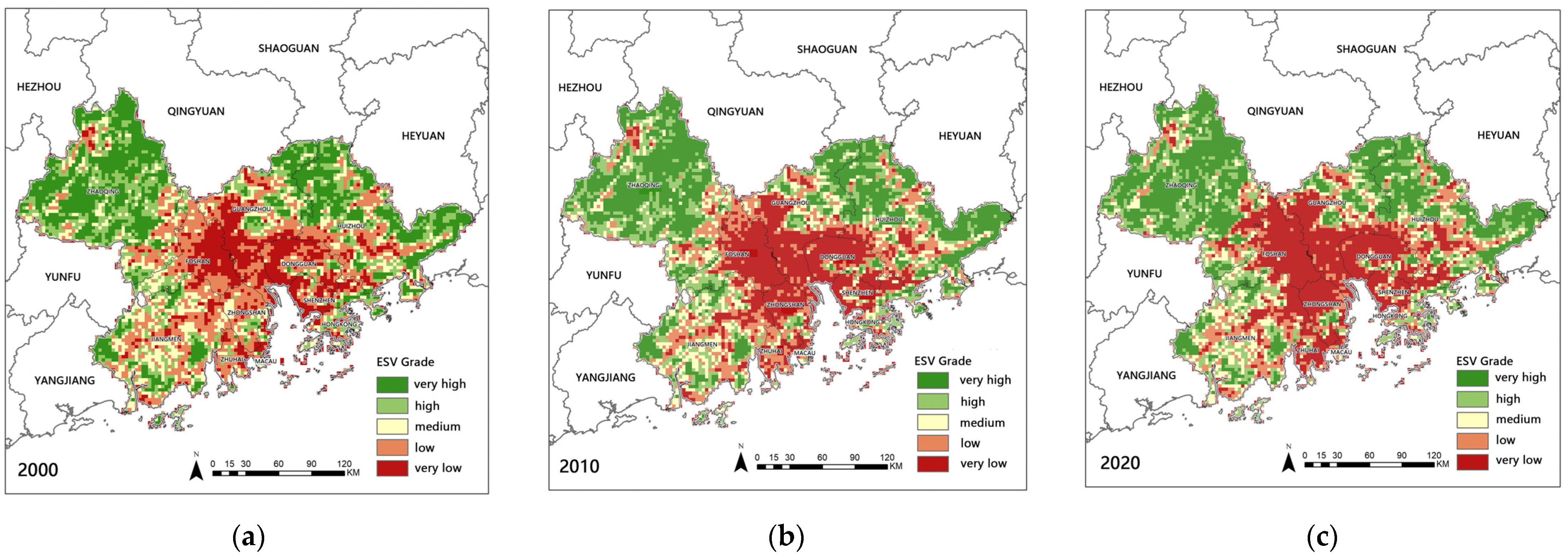



| Ecosystem Services | Arable Land | Woodland | Grassland | Water | Unused Land | Construction Land |
|---|---|---|---|---|---|---|
| Food production | 1833.63 | 605.10 | 788.46 | 971.82 | 36.67 | - |
| Raw material production | 715.12 | 5464.22 | 660.11 | 641.77 | 73.35 | - |
| Atmospheric regulation | 1320.21 | 7921.28 | 2750.44 | 935.15 | 110.02 | - |
| Climate regulation | 1778.62 | 7462.87 | 2860.46 | 3777.28 | 238.37 | - |
| Hydrological regulation | 1411.90 | 7499.55 | 2805.45 | 34,417.24 | 128.35 | −6678.00 |
| Waste disposal | 2548.75 | 3153.84 | 2420.39 | 27,229.41 | 476.74 | −2174.10 |
| Soil maintenance | 2695.44 | 7371.19 | 4107.33 | 751.79 | 311.72 | 3480.00 |
| Biodiversity maintenance | 1870.30 | 8269.67 | 3428.89 | 6289.35 | 733.45 | - |
| Recreation | 311.72 | 3813.95 | 1595.26 | 8141.32 | 440.07 | - |
| Total | 14,485.68 | 51,561.68 | 21,416.80 | 83,155.12 | 2548.75 | −5372.10 |
| 2000 | 2010 | |||||
|---|---|---|---|---|---|---|
| Arable Land | Woodland | Grassland | Water | Construction Land | Unused Land | |
| Arable land | 11,794.79 | 200.47 | 6.57 | 640.16 | 1788.17 | 0.14 |
| Woodland | 146.54 | 29,617.05 | 23.74 | 65.25 | 755.93 | 0.39 |
| Grassland | 10.14 | 76.23 | 1063.23 | 11.52 | 64.40 | 0.03 |
| Water | 542.56 | 39.28 | 4.26 | 3152.38 | 511.80 | 0.03 |
| Construction land | 130.03 | 92.71 | 3.79 | 71.54 | 4135.00 | 0.05 |
| Unused land | 2.10 | 0.91 | 0.02 | 3.23 | 6.61 | 10.63 |
| 2010 | 2020 | |||||
| Arable Land | Woodland | Grassland | Water | Construction Land | Unused Land | |
| Arable land | 10,971.15 | 760.73 | 36.61 | 244.38 | 2407.70 | 9.73 |
| Woodland | 617.77 | 28,671.65 | 221.40 | 115.43 | 973.95 | 8.69 |
| Grassland | 42.13 | 270.49 | 820.73 | 11.59 | 79.91 | 0.71 |
| Water | 1169.43 | 144.25 | 11.69 | 2108.89 | 736.71 | 79.34 |
| Construction land | 232.96 | 122.17 | 5.63 | 34.43 | 4026.30 | 11.63 |
| Unused land | 3.44 | 1.85 | 0.14 | 0.18 | 6.74 | 11.17 |
| Type of Land Use | 2000–2010 | 2010–2020 | ||
|---|---|---|---|---|
| Transfer Distance | Transfer Direction | Transfer Distance | Transfer Direction | |
| Arable land | 3733 | Northwest | 3625 | West |
| Woodland | 1171 | Northwest | 591 | Southeast |
| Grassland | 2935 | Northwest | 19,962 | Northwest |
| Water | 3448 | South | 4276 | Southeast |
| Construction land | 3602 | North | 936 | Southeast |
| Unused land | 11,086 | East | 24,404 | Southwest |
| Ecosystem Service Functions | 2000 | 2010 | 2020 | |||||||
|---|---|---|---|---|---|---|---|---|---|---|
| ESV | Contribution Rate (%) | Class | ESV | Contribution Rate (%) | Class | ESV | Contribution Rate (%) | Class | ||
| Supply Services | Food production | 50.55 | 2.33 | 9 | 46.69 | 2.25 | 9 | 45.29 | 2.36 | 9 |
| Raw material production | 182.23 | 8.41 | 7 | 177.95 | 8.56 | 7 | 175.06 | 9.12 | 7 | |
| Reconciliation Services | Atmospheric regulation | 270.50 | 12.48 | 5 | 263.59 | 12.68 | 5 | 259.44 | 13.52 | 4 |
| Climate regulation | 275.75 | 12.72 | 4 | 267.60 | 12.87 | 4 | 258.97 | 13.50 | 5 | |
| Hydrological regulation | 377.05 | 17.40 | 1 | 344.90 | 16.59 | 1 | 277.16 | 14.44 | 3 | |
| Support Services | Waste disposal | 247.68 | 11.43 | 6 | 229.28 | 11.03 | 6 | 180.65 | 9.41 | 6 |
| Soil maintenance | 289.92 | 13.38 | 3 | 289.89 | 13.94 | 3 | 290.58 | 15.14 | 2 | |
| Biodiversity maintenance | 313.71 | 14.48 | 2 | 304.34 | 14.64 | 2 | 291.28 | 15.18 | 1 | |
| Cultural Services | Recreation | 159.83 | 7.37 | 8 | 155.27 | 7.47 | 8 | 140.34 | 7.31 | 8 |
| Total | 2167.22 | 100 | - | 2079.50 | 100 | - | 1918.76 | 100 | - | |
| Year | Very Low | Low | Medium | High | Very High |
|---|---|---|---|---|---|
| 2000 | 1092 | 1577 | 1091 | 1157 | 1534 |
| 2010 | 1543 | 1159 | 933 | 1055 | 1761 |
| 2020 | 1757 | 992 | 916 | 1046 | 1740 |
| Year | ESV Reduction Zone (<−2.4 × 106 CNY/hm2) | ESV No Significant Change Zone (−2.4–2.4 × 106 CNY/hm2) | ESV Increase Zone (>2.4 × 106 CNY/hm2) |
|---|---|---|---|
| 2000–2010 | 1875 | 2387 | 2189 |
| Proportion | 29 | 37 | 34 |
| 2010–2020 | 2098 | 3373 | 980 |
| Proportion | 33 | 52 | 15 |
| 2000–2020 | 2286 | 2436 | 1729 |
| Proportion | 35 | 38 | 27 |
| Ecosystem Service Types | Ecosystem Services | Arable Land | Woodland | Grassland | Water | Unused Land | Construction Land | Total |
|---|---|---|---|---|---|---|---|---|
| Supply Services | Food production | 23.930 | 18.121 | 0.861 | 1.697 | 0.006 | 0.000 | 44.616 |
| Raw material production | 9.333 | 163.641 | 0.721 | 1.121 | 0.012 | 0.000 | 174.828 | |
| Reconciliation Services | Atmospheric regulation | 17.230 | 237.224 | 3.005 | 1.633 | 0.018 | 0.000 | 259.110 |
| Climate regulation | 23.212 | 223.496 | 3.125 | 6.598 | 0.039 | 0.000 | 256.470 | |
| Hydrological regulation | 18.426 | 224.594 | 3.065 | 60.115 | 0.021 | −60.090 | 246.131 | |
| Support Services | Waste disposal | 33.263 | 94.450 | 2.644 | 47.560 | 0.078 | −19.563 | 158.433 |
| Soil maintenance | 35.177 | 220.750 | 4.487 | 1.313 | 0.051 | 31.314 | 293.093 | |
| Biodiversity maintenance | 24.409 | 247.658 | 3.746 | 10.985 | 0.121 | 0.000 | 286.918 | |
| Cultural Services | Recreation | 4.068 | 114.219 | 1.743 | 14.220 | 0.072 | 0.000 | 134.322 |
| Total | 189.048 | 1544.154 | 23.395 | 145.244 | 0.419 | −48.339 | 1853.921 | |
| Year | 2000 | 2010 | 2020 |
|---|---|---|---|
| Local R2 | 0–0.8541 | 0–0.8532 | 0–0.8584 |
| R2 | 0.8022 | 0.8267 | 0.8317 |
| Adjusted R2 | 0.7883 | 0.8146 | 0.8200 |
| AICC | 256,353.8 | 256,973.8 | 256,797.1 |
Disclaimer/Publisher’s Note: The statements, opinions and data contained in all publications are solely those of the individual author(s) and contributor(s) and not of MDPI and/or the editor(s). MDPI and/or the editor(s) disclaim responsibility for any injury to people or property resulting from any ideas, methods, instructions or products referred to in the content. |
© 2023 by the authors. Licensee MDPI, Basel, Switzerland. This article is an open access article distributed under the terms and conditions of the Creative Commons Attribution (CC BY) license (https://creativecommons.org/licenses/by/4.0/).
Share and Cite
Li, H.; Huang, Y.; Zhou, Y.; Wang, S.; Guo, W.; Liu, Y.; Wang, J.; Xu, Q.; Zhou, X.; Yi, K.; et al. Spatial and Temporal Evolution of Ecosystem Service Values and Topography-Driven Effects Based on Land Use Change: A Case Study of the Guangdong–Hong Kong–Macao Greater Bay Area. Sustainability 2023, 15, 9691. https://doi.org/10.3390/su15129691
Li H, Huang Y, Zhou Y, Wang S, Guo W, Liu Y, Wang J, Xu Q, Zhou X, Yi K, et al. Spatial and Temporal Evolution of Ecosystem Service Values and Topography-Driven Effects Based on Land Use Change: A Case Study of the Guangdong–Hong Kong–Macao Greater Bay Area. Sustainability. 2023; 15(12):9691. https://doi.org/10.3390/su15129691
Chicago/Turabian StyleLi, Hui, Yilin Huang, Yilu Zhou, Shuntao Wang, Wanqi Guo, Yan Liu, Junzhi Wang, Qing Xu, Xiaokang Zhou, Kexin Yi, and et al. 2023. "Spatial and Temporal Evolution of Ecosystem Service Values and Topography-Driven Effects Based on Land Use Change: A Case Study of the Guangdong–Hong Kong–Macao Greater Bay Area" Sustainability 15, no. 12: 9691. https://doi.org/10.3390/su15129691
APA StyleLi, H., Huang, Y., Zhou, Y., Wang, S., Guo, W., Liu, Y., Wang, J., Xu, Q., Zhou, X., Yi, K., Hou, Q., Liao, L., & Lin, W. (2023). Spatial and Temporal Evolution of Ecosystem Service Values and Topography-Driven Effects Based on Land Use Change: A Case Study of the Guangdong–Hong Kong–Macao Greater Bay Area. Sustainability, 15(12), 9691. https://doi.org/10.3390/su15129691






